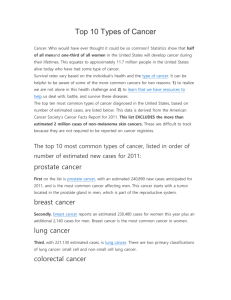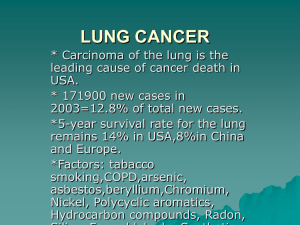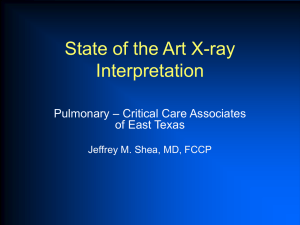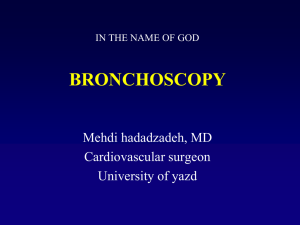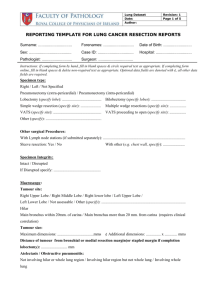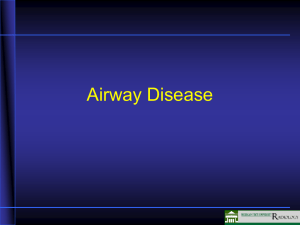Chest
advertisement
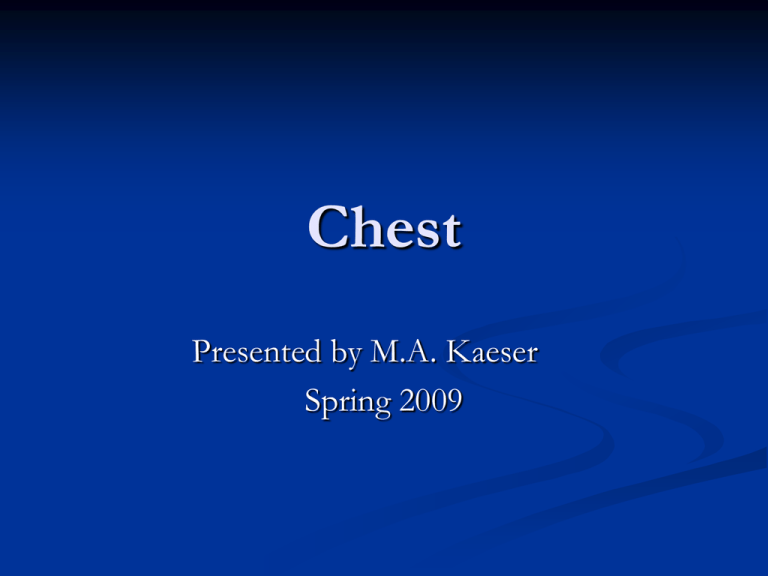
Chest Presented by M.A. Kaeser Spring 2009 Search Pattern 5 Steps Soft tissues Bones Central shadow Hila Lung Fields http://medinfo.ufl.edu/year1/rad6190/images/pa_ chest_xray.gif Soft Tissues Examine Axilla Underneath diaphragm Muscles Neck http://www.health.com/health/static/hw/media/ medical/hw/h9991297_001.jpg Bone Ribs Vertebral Column http://www.med.yale.edu/intmed/cardio/imaging/findings/normal_ chest_pa2/graphics/rad1.gif Central Shadow Includes Heart Trachea Aorta Arch Ascending aorta Descending aorta http://www.medicine.cu.edu.eg/english/students/study/x_ray_surgery /xray/chest/130_normal_chest_male Hila Two Right Left Pulmonary vasculature starts there and goes out to lungs Convexity toward spine and concavity to lungs If you see fuzzy looking stuff, bronchogenic carcinoma until proven otherwise Lateral Chest Same search pattern: Anterior mediastinum – posterior border of heart to sternum Middle mediastinum – heart to anterior 1/3 of vertebral bodies Posterior mediastinum – rest of vertebral bodies, posterior 2/3 Anterior Mediastinum 5 terrible T’s Thyroid cancer Thymoma (myasthenia gravis) Terrible lymphoma Terrible aneurysm – from ascending aorta Teratoma Middle Mediastinum Normally messy on chest film because of vasculature Bronchogenic carcinoma or lymphoma 13% of patients will live 5 years after diagnosis of bronchogenic carcinoma Posterior Mediastinum Neural tumors Neurofibroma Meningioma Schwannoma Paraspinal mass Abscess with TB infection Hematoma with compression fracture Aneurysm From descending aorta Hilum Region of blood vessels and lymph nodes Normal hilum has a convexity that points to midline Unilateral hilar mass If not, think COPD, CHF, pulmonary hypertension Bronchogenic carcinoma until proven otherwise Lymphoma Bilateral hilar mass (rare) Bilateral soft tissue masses are usually benign 1, 2, 3 Sign 3 Enlargements of lymph nodes = Sarcoidosis or lymphoma Right paratracheal lymph node enlargement (can be left, but usually right) Bilateral hilar lymph node enlargement May be referred to as potato nodes when the lymph nodes become enlarged KVEIM and ACE tests are to detect sarcoidosis Lymphenopathy Bilateral hilar lymphadenopathy (infection) Lymphoma High white cell count Pulmonary artery hypertension Artery can enlarge Can look like mass in hilum Probably due to COPD Emphysema (pictured) Chronic bronchitis Chronic asthma http://cache2.asset-cache.net/xc/85324603.jpg?v=1&c=NewsMaker&k=2&d=EDF6F2F 4F969CEBD0F7E3B05BED0A88EE23D8C43D9EAB1023A96F14DDD9B947D Chronic Lung Disease Right side of lung is affected Right sided heart enlargement due to pulmonary dysfunction – cor pulmonale Lung Fields Increased density Patient rotation – lung field that is away will have more density (check the clavicles) Mass – usually not diffuse density Consolidation Infection (pneumonia) – lung will fill with fluid/mucus Pneumonia Note the indistinct borders, air bronchograms, and silhouetting of the right heart border http://www.med-ed.virginia.edu/courses/rad/cxr/web%20images/rml-pneumonia-pa1b.jpg Lung Fields Decreased Density Emphysema – lungs are hyper-inflated, full of air Pneumothorax – collapse of lung Pneumothorax Trachea Tracheal shadow should be in midline Atelectasis will pull the trachea Cancer, thyroid, parathyroid lymph nodes will push trachea Atelectasis The area that is collapsed will be opacified Breath sounds are decreased In patient over 40 years of age – bronchogenic carcinoma is the main cause In patient under 40, TB Indirect signs Hilar displacement, rib space narrowing, diaphragm displacement, mediastinal displacement, tracheal deviation Direct signs Fissure displacement (horizontal fissure should be in 4th anterior intercostal space) Bronchogenic Carcinoma Main risk factors Primary smoking Second-hand smoke Radon gas http://img.medscape.com/pi/emed/ckb/radiology/336139-358433-914tn.jpg Azygous Lobe Azygous vein runs along posterior wall of thoracic cage Vein pierces lung tissue and pulls visceral and parietal pleura along with it Looks like a separation from the lung No clinical significance http://upload.wikimedia.org/wikipedia/commons/thumb/8/88/Lobus_venae_azygos_ Silhouette Sign Two soft tissue densities that are next to each other Unable to distinguish between the two densities Example: heart shadow and mass growing next to it (always abnormal) Soft Tissue Densities > 3 cm = bronchogenic carcinoma, metastatic carcinoma, abscess (TB, mycoplasm, staphylococcus) < 3 cm = nodules > 3 cm = mass Solitary Pulmonary Nodule Soft tissue mass less than 3 cm – consider bronchogenic carcinoma, solitary metastasis, or granuloma (small abscess, no calcification is seen) No way to distinguish on plain film between these three differentials Perform further imaging (CT usually) – if patient is under 35 years old, watchful waiting, every 6 months take an x-ray If patient under age of 70, 60% chance it is granuloma If patient over age of 70, 60% chance that it is malignant (bronchogenic carcinoma or metastasis)
